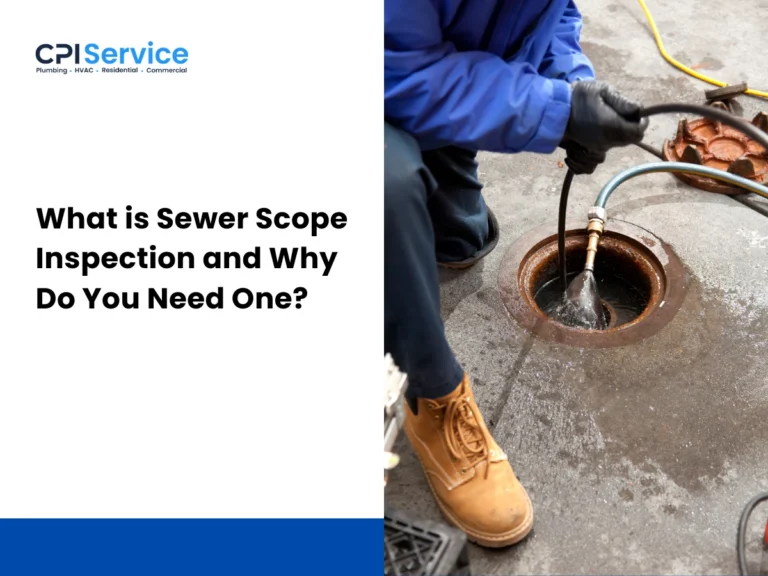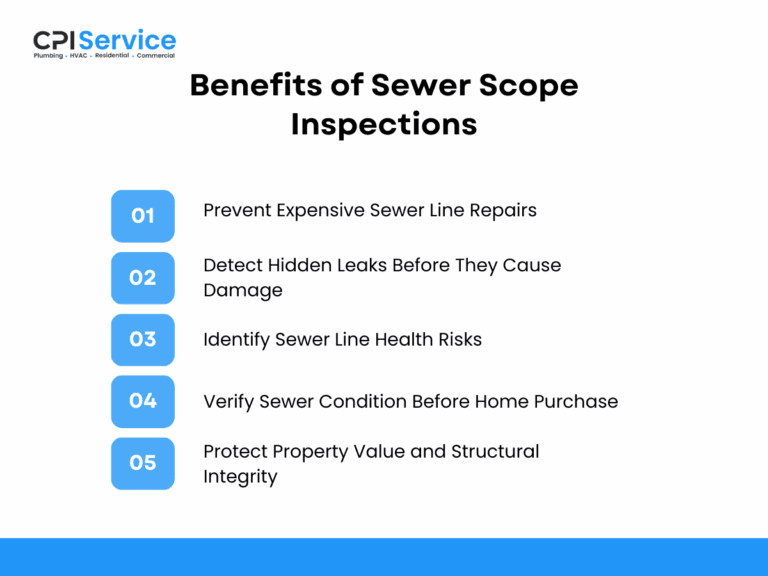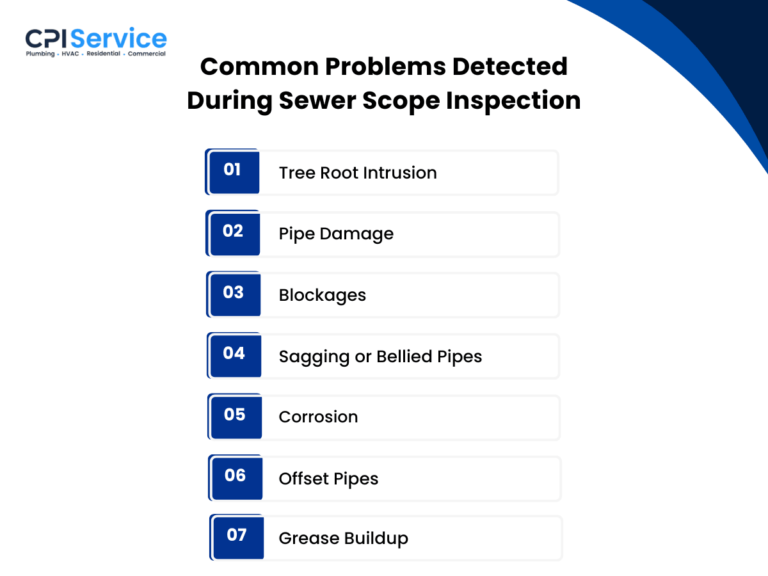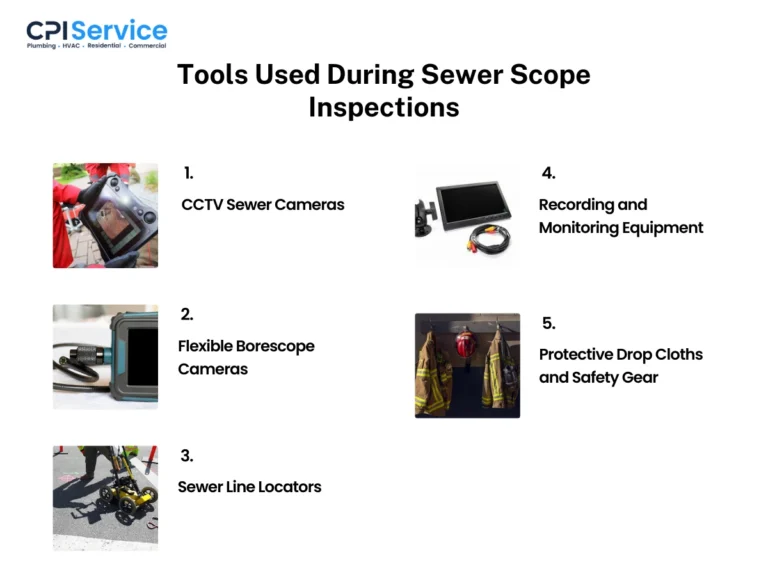What is Sewer Scope Inspection and Why Do You Need One?
A sewer scope inspection is a specialized procedure that uses a borescope camera to examine the interior of your home’s sewer lines. This non-invasive method offers a clear view of potential plumbing issues, such as blockages, leaks, and pipe damage, without the need for excavation.
During the inspection, the high-definition camera is inserted into the sewer line through an access point, like a cleanout. As it moves through the pipes, it captures real-time footage, allowing professionals to identify issues such as tree root intrusions, misaligned pipes, or corrosion. This detailed inspection enables professionals to recommend the best solution, whether it’s a routine cleaning, a targeted repair, or full pipe replacement. Plumbing scope inspections are invaluable for detecting plumbing problems early, helping to avoid costly repairs and major plumbing disasters down the road.
Whether you are performing routine maintenance, buying a new home, or dealing with recurring plumbing issues, a sewer scope inspection can save you from unexpected expenses. For homebuyers, it ensures the sewer system is in good condition, preventing surprises after purchase. For homeowners, it is a proactive way to catch small issues before they turn into costly repairs.

Benefits of Sewer Scope Inspections
Sewer scope inspections provide a proactive approach to maintaining your home’s plumbing system by identifying potential issues before they lead to costly repairs or significant damage.

Key benefits of scheduling a sewer scope inspection are:
- Prevent Expensive Sewer Line Repairs: A sewer scope inspection can catch problems like blockages, cracks, or tree root intrusions early, preventing the need for costly repairs or even a full sewer line replacement. By addressing issues promptly, homeowners can avoid emergency plumbing costs and the disruption of major repairs.
- Detect Hidden Leaks Before They Cause Damage: Performing a plumbing scope inspection allows homeowners to identify leaks early, which are often hidden and go unnoticed until significant damage occurs. This enables them to resolve the issues before they lead to water damage, mold growth, or structural issues in the home.
- Identify Sewer Line Health Risks: Through a sewer scope inspection, you can detect issues like cracks, corrosion, or misalignment before they escalate. This helps reduce the risk of serious health hazards such as sewage backups, flooding, or contamination, which can be harmful to both health and property.
- Verify Sewer Condition Before Home Purchase: For prospective homeowners, a sewer scope inspection helps verify the condition of the sewer line. It uncovers potential issues like root intrusion, blockages, or wear and tear that may require costly repairs or replacements down the road, helping to avoid post-purchase surprises.
- Protect Property Value and Structural Integrity: Conducting regular sewer scope inspections ensures that the sewer lines remain in good condition, preventing issues like leaks or root damage that could undermine the foundation or structure of the home. This proactive approach also helps maintain the property’s market value over time.
Common Challenges in Sewer Scope Inspections
Sewer scope inspections, while highly effective, come with several challenges that can affect their accuracy or completeness. Below are some of the common obstacles that may arise during an inspection:
- Equipment Limitations: Sewer scope cameras have a limited reach, meaning they may not be able to fully navigate longer or more complex sewer lines. This can result in missed issues, particularly in hard-to-reach areas or pipes with sharp bends.
- Obstructions: Tree roots, heavy debris, and other blockages can obstruct the camera’s path, making it difficult to inspect the full length of the pipe. In these cases, the inspection may only capture partial footage, requiring further investigation or additional cleaning.
- Hidden Defects: Some issues, such as corrosion or pipe misalignment, may not be fully visible during the inspection, especially if they are covered by debris or inside the pipe itself.
- Access Issues: Sewer lines that are buried too deep or under structures like concrete slabs can pose access challenges, requiring additional tools or methods to complete a thorough inspection.
Common Problems Detected During Sewer Scope Inspection
Sewer scope inspections are essential for identifying hidden issues within your sewer lines that can lead to major plumbing problems if left untreated. These inspections provide valuable insight into the condition of your pipes and help prevent costly repairs.

Here are some of the most common issues detected during a sewer scope inspection:
- Tree Root Intrusion: Tree roots can penetrate sewer pipes through cracks or joints, causing blockages, slow drainage, and pipe damage. Early detection prevents roots from causing further harm or requiring costly pipe replacement.
- Pipe Damage: Cracks, breaks, or even collapsed pipes disrupt the flow of waste and wastewater. These issues are often caused by ground movement, aging pipes, or improper installation, and can lead to costly repairs if not caught early.
- Blockages: Sewer pipes can become clogged with debris, grease, hair, or other materials, leading to partial or complete blockages. These blockages restrict the flow of wastewater, causing slow drainage, foul odors, and the risk of sewage backups in your home or yard.
- Sagging or Bellied Pipes: Over time, sewer pipes may sag or develop low spots due to ground settling or improper installation. These low spots, known as “bellies,” trap waste and debris, causing slow drainage, clogs, and backups in the sewer system.
- Corrosion: Aging pipes, especially those made from materials like cast iron, are prone to corrosion, which weakens the pipe structure and leads to leaks or holes. Corroded pipes can cause significant water damage and may need to be replaced to restore the integrity of the system.
- Offset Pipes: Shifting soil or movement in the ground can cause sewer pipes to misalign at their joints, leading to offsets. This misalignment disrupts the flow of wastewater and can cause blockages, backups, or the need for extensive repairs.
- Grease Buildup: Grease and fats from cooking can build up inside sewer pipes over time, causing blockages and restricting the flow of wastewater. If not removed, grease buildup can lead to severe clogs and expensive repairs.
Signs You Need a Sewer Scope Inspection
If you notice water backups in multiple drains, foul sewage odors, slow drainage, or even visible sinkholes in your yard, it may be time to schedule a sewer scope inspection. These signs often indicate underlying sewer line issues that, if left unchecked, can lead to major damage. In such cases, it is important to contact professional sewer line inspection services to properly assess and address the problem. These professionals have the right tools and expertise to conduct a thorough inspection and identify issues that are not visible to the untrained eye.
Here are some key indicators that it is time to schedule a plumbing scope inspection:
- Water Backups in Multiple Drains: If water is backing up in multiple drains, it is a clear sign that your sewer line is clogged or damaged. A sewer scope inspection helps identify the location and extent of the blockage, allowing you to resolve the issue before it leads to full sewer backups or overflows, which can cause significant water damage.
- Sewage Odors Inside or Outside the Home: Foul sewage odors inside your home or in your yard often point to a problem with your sewer line, such as cracks, blockages, or leaks. A sewer scope inspection helps pinpoint the exact source of the odors, whether it is from a crack, leak, or clog, and provides the necessary information to fix the issue before contamination or health risks arise.
- Unexplained Lush Green Patches in the Yard: Lush green patches or unusually thick grass in your yard can be a sign of a sewer line leak, where waste or water from the pipes acts as a fertilizer. A sewer scope inspection helps confirm whether there is a leak, preventing further damage to your landscaping, and identifying whether a pipe replacement or repair is needed.
- Foundation Cracks or Structural Shifting: If you notice cracks in your foundation or shifting in the structure of your home, it could be caused by leaking sewer lines undermining the soil. A sewer scope inspection can detect leaks, allowing you to address the issue before it compromises the structural integrity of your home, potentially saving you from expensive repairs.
- Rodent or Pest Infestation Near Sewer Lines: An increase in pests or rodents near your sewer lines could be due to gaps or cracks in the pipes. These openings can allow pests to enter your home, posing a health risk. A sewer scope inspection helps identify these vulnerable areas, enabling you to seal the gaps and prevent further infestation.
- Slow Drainage Throughout the House: Slow drainage in multiple sinks, showers, or bathtubs often points to a problem in the sewer system. A sewer scope inspection will determine whether a partial blockage or pipe damage is causing the issue, and it can help you take the appropriate action to prevent future clogs or backups.
- Visible Sinkholes or Soil Depressions: Sinkholes or depressions in your yard are signs of potential sewer line collapse or significant leaks. A sewer scope inspection identifies the source of the problem, allowing you to address the damage before it worsens and causes more extensive issues, such as structural damage to your property.
Tools Used During Sewer Scope Inspections
To conduct a thorough sewer scope inspection, professionals rely on specialized tools like CCTV sewer cameras, flexible borescopes, and sewer line locators. These tools allow inspectors to access hard-to-reach areas, capture real-time footage, and accurately pinpoint issues in the sewer system.

Some essential tools used during a sewer scope inspection are:
- CCTV Sewer Cameras: Used as the primary inspection tool, CCTV sewer cameras are inserted into the sewer lines to provide real-time video footage. These high-definition cameras provide a clear view of potential issues, such as blockages, cracks, corrosion, or tree root intrusion, allowing plumbers to identify the exact cause of plumbing problems without needing to dig up the yard.
- Flexible Borescope Cameras: For areas that are hard to reach or contain sharp bends, flexible borescope cameras are essential. Their flexible cable allows them to reach areas that a standard CCTV camera might not, making them ideal for inspecting smaller pipes or complex sewer systems with multiple turns. These cameras help detect hidden issues like misaligned pipes or small cracks that could lead to more significant problems.
- Sewer Line Locators: Sewer line locators are essential for identifying the exact location and depth of sewer pipes underground. Using sonar or electromagnetic signals, these tools help locate the sewer line accurately, especially in areas where the pipes are buried deep or under heavy structures like driveways or concrete. This prevents unnecessary digging and helps inspectors assess the situation with minimal disruption to the property.
- Recording and Monitoring Equipment: During the inspection, recording equipment is used to capture video footage of the sewer line as it is being inspected. This footage is stored for review and can be shared with homeowners to provide a visual of any issues found. Additionally, monitoring equipment also allows certified home inspectors to analyze live footage and document any issues for later use in determining necessary repairs or replacements.
- Protective Drop Cloths and Safety Gear: Since sewer scope inspections involve working with potentially hazardous materials, safety gear such as gloves, goggles, and face shields is essential to protect the professionals. Drop cloths are also used to cover the surrounding area to keep the inspection site clean while preventing dirt, debris, or sewage from spilling onto the property during the process.
What Does the Sewer Scope Inspection Process Consist of?
A sewer scope inspection process involves several key steps, from locating access points to providing a detailed video report of the sewer line’s condition. Each step ensures that potential issues are identified and documented for future repairs.
Below is an overview of the entire sewer scope inspection process:
- Locate Cleanout Access and Map Sewer Line Path: The inspection begins by locating the cleanout access, which serves as the entry point for the camera into the sewer line. The certified home inspector maps out the path of the sewer line to ensure all areas are covered, especially those that might be difficult to reach. This mapping helps guide the camera through the system and allows the inspector to monitor the condition of the entire sewer network.
- Set Up and Test Sewer Camera Equipment: Before beginning the inspection, the camera and other equipment are carefully set up and tested for functionality. This includes checking the camera’s battery, lighting, and video quality to ensure the footage is clear. The inspector also ensures the camera’s signal strength is sufficient for transmitting footage without interruption, ensuring a smooth inspection process.
- Insert Camera into Sewer Line and Navigate: The camera is then inserted into the sewer line through the cleanout access point. A licensed plumber guides the camera through the pipes, making sure it moves smoothly and capturing video footage along the way. Special attention is given to areas of the pipe where issues are most likely to occur, such as turns, joints, and vulnerable pipe sections, ensuring that nothing is missed.
- Document Blockages, Cracks, and Other Defects: As the camera moves through the sewer line, the inspector documents any issues found, including blockages (due to debris or roots), cracks, misalignments, or corrosion. The footage is analyzed in real-time, and the inspector notes the severity of each problem, helping determine whether repairs, maintenance, or replacements are necessary.
- Mark Problem Areas and Provide Final Video Report: Once problem areas are identified, the inspector marks these spots for further investigation or repair. A final video report is then compiled, showing the footage of the inspection along with notes on the issues found. This report is shared with the homeowner, providing a visual overview of the sewer system’s condition, helping to plan for any necessary repairs or replacements.
Types of Sewer Scope Inspections
Sewer scope inspections range from high-tech CCTV inspections to more traditional manual methods, each offering different levels of detail and suited to various types of plumbing assessments. These inspections are designed to identify potential issues within the sewer system, helping homeowners and professionals detect problems early to avoid costly repairs.
CCTV Inspections
When it comes to providing the most detailed and precise insight into a sewer system’s condition, CCTV inspections are the most reliable choice. High-definition cameras, typically mounted on flexible cables, are inserted into the sewer lines, capturing real-time video footage of the interior of the pipes. This allows inspectors to detect a wide range of issues, such as blockages caused by debris or tree roots, cracks, misalignments, corrosion, and even structural issues like pipe sagging. The footage is transmitted to a monitor for detailed analysis, and the non-invasive nature of CCTV inspections eliminates the need for costly excavation, ensuring a thorough inspection without disrupting the property.
Camera Inspections
For assessing smaller or less complicated sewer systems, camera inspections are a cost-effective and efficient option. These inspections typically use waterproof, high-resolution cameras that provide live video feeds of the sewer line’s interior. The camera moves through the pipes to identify common issues, such as minor blockages, leaks, and misalignments, which may not be as critical but still require attention. While not as detailed as CCTV inspections, camera inspections are an ideal choice for routine maintenance or initial assessments, allowing for quick identification of visible issues without the need for more complex technology.
Visual Inspections (Traditional)
In situations where minimal technology is required, traditional visual inspections involve manually checking the accessible parts of the sewer system. Certified home inspectors use probes, handheld cameras, or mirrors to visually inspect the pipes and look for obvious issues like cracks, surface damage, or minor blockages. This method is particularly useful for quickly identifying external problems, such as signs of damage near access points or easily visible obstructions. While this method does not provide the depth of camera-based inspections, it is an affordable and effective approach for inspecting the condition of exposed or easily accessible sewer lines.
Sewer Line Locating
To map out the exact path of underground sewer lines, sewer line locating tools are employed. This method uses specialized equipment, such as sonar or electromagnetic signals, to trace the sewer line’s route and depth below ground. The locator emits signals that are detected by a receiver, allowing inspectors to pinpoint the exact location and layout of the sewer system, even when the pipes are buried deep or obstructed by structures like concrete. Sewer line locating is critical for accurately identifying the path of the sewer lines to avoid unnecessary excavation, especially when planning repairs, replacements, or new installations.
What Is the Average Cost of a Sewer Scope Inspection?
The average cost of a sewer scope inspection ranges from $250 to $500, with prices exceeding the $1,700 mark. Several factors influence the price, including the location of the property, the complexity of the sewer system, and the inspection company’s pricing structure. For example, if the sewer line is difficult to access or requires additional equipment, the cost may be higher.
In some cases, sewer scope inspections may be bundled with other plumbing services, which could affect the final price. It is important to get a clear quote from the inspection company before scheduling the service. While it may seem like a significant expense, the cost of a sewer scope inspection is far lower than the potential cost of major plumbing repairs that could arise from undetected issues.
Regulations for Sewer Scope Inspections
Sewer scope inspections are subject to various regulations that ensure a comprehensive and reliable assessment of a property’s plumbing system. These regulations are especially important in areas like California, where laws mandate specific inspections as part of real estate transactions. Here are the key regulations you should be aware of:
- California Sewer Inspection Mandate: In California, homes built before 1980 are required to undergo a sewer scope inspection as part of the real estate transaction process. Chapter 14.08 Sewerage System Operations, specifically Section 14.10.440, grants the city the right to inspect and monitor sewer systems to ensure compliance with applicable regulations. This includes the right to access properties for inspection and to set up necessary equipment like meters for sampling and compliance monitoring. The mandate helps protect homebuyers from unexpected sewer issues by ensuring that the sewer system is thoroughly inspected before the property changes hands.
- Local Real Estate Requirements: Many local jurisdictions impose their regulations regarding sewer inspections, particularly in real estate transactions. For example, in Portland, Oregon, sewer scope inspections are required for homes over 20 years old when the property is sold. These inspections help buyers assess the condition of the sewer lines and identify potential problems such as tree root intrusion or pipe damage. Local requirements like these ensure that the inspection process is thorough and transparent, protecting both buyers and sellers.
Frequently Asked Questions (FAQs) About Sewer Scope Inspections
Is a Sewer Scope Part of a Home Inspection?
No, a sewer scope inspection is not typically part of a standard home inspection. It is a separate service that focuses specifically on the condition of the sewer lines, which requires specialized equipment and expertise.
When Should You Get a Sewer Scope Inspection?
You should get a sewer scope inspection before buying a home, during routine plumbing maintenance every 3-5 years, or if you are experiencing drainage issues, slow drainage, or sewage odors. It is a proactive step to catch potential problems early and prevent costly repairs.
Is It Worth Getting a Sewer Scope for a New Home?
Yes, it is worth getting a sewer scope inspection for a new home. Even newly constructed homes can have issues like poor installation or construction damage that a sewer scope inspection can help identify before they become major problems.

Alex Hamilton
Alex Hamilton is the owner of CPI Service, a trusted provider of plumbing and HVAC solutions. With over 35+ years of hands-on experience in the industry, He brings deep technical expertise and a proven track record in delivering reliable installation, maintenance, and repair services. His leadership ensures that CPI Service consistently upholds the highest standards of quality, safety, and customer satisfaction.
